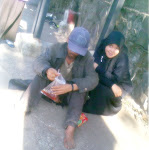Basic Concept Theory
A. Definition
Losing is a state of individuals who parted with something that previously existed, and then becomes nothing, good things happen in part or whole (Lambert and Lambert, 1985, h.35). Loss of an experience ever experienced by each individual in the span of life. Since the birth of individuals have experienced a loss and tend to experience it again, although in a different form.
Regardless of the cause of loss experienced by each individual will respond to situations of loss, the last response to loss is influenced by the previous loss.
Elizabeth Kubler-rose, 1969.h.51, divides grief response in five phases, namely: pengikaran, anger, bargaining, depression and acceptance.
B. Response Range Loss
Images range of individual responses to loss (Kublier-rose, 1969).
Anger Phase Phase Depression
__________________________________________________________
Denial Phase Phase Phase Bargaining Receiving
Denial Phase
The first reaction of individuals who experience loss is shock, do not believe or deny the fact that life is indeed true, by saying "No, I do not believe it happened" or "it is impossible". For individuals or families diagnosed with a terminal illness, will continue to seek additional information.
Physical reactions that occur in this phase are: fatigue, weakness, pallor, diarrhea, breathing difficulties, rapid heart rate, crying, anxiety, and do not know what to do. This reaction can be ended within a few minutes or a few years.
Anger Phase
This phase begins with the emergence of an awareness of the reality of the loss of individual shows increasing anger is often projected onto others or to himself. Not infrequently he showed aggressive behavior, speaking harshly, refusing treatment, the doctor-nurse accused of not pecus. Physical response that often occurs between the other red face, rapid pulse, anxiety, difficulty sleeping, hands clenched.
Bargaining Phase
Individuals have been able to express her anger intensely, then he will go to the bargaining phase with pleading mercy of God. This response is often expressed with the words "if only this could be delayed, then I would often pray". When this process by the statement that families often go out is "if only the sick, not my child".
Depression Phase
Individuals in this phase often show withdrawal, sometimes as a patient is very obedient, do not want to talk, express despair, feelings of worthlessness, no suicide, etc.. Physical symptoms presented include: refusing to eat, sleep, fatigue, boost libido manurun.
Acceptance Phase
This phase is associated with the reorganization of the loss. The mind that is always centered to the object or the missing person will begin to decrease or disappear. Individuals who have received loss suffered. The image of an object or a person who lost starting gradually released and attention will shift to the new object. This phase is usually expressed with "I really lose my clothes but this outfit looks nice" or "what can I do to get better soon".
If the individual can start this phase and received with a sense of peace, then he will end the grieving process and cope with feelings of loss with completely. But if not able to accept this phase it will affect their ability to cope with feelings of loss the next.
C. FACTORS AFFECTING REACTION LOSS, RELIANCE:
1. The meaning of loss
2. Social culture
3. faith / spiritual
4. Sex Roles
5. Economic social status
6. physical and psychological condition of individuals
D. LOST IN SHARED 2 TIFE:
1. Actual or real
Easily recognized or identified by others, such as amputations, death of a very mean / in love.
2. Perception
Only experienced by a person and is difficult to be proved, for example, someone who
stop work / laid off, causing a feeling of independence and freedom to
decreased.
E. LOSS FACTOR causes:
1. Losing a loved / respected
Permanent nature ==> can not personal contacts.
2. Loss of physical well-being, psychological and social.
3. Loss of objects outside ourselves
4. Lost due to separation from familiar surroundings.
F. Basic concepts of nursing Orphanage
A. Nursing Diagnosis
1. Social isolation: withdrawal associated with low self-esteem / chronic.
2. Self-concept disturbances: chronic low self-esteem associated with individual köping ineffective response secondary to loss of a spouse.
3. Self-care deficit related to activity intolerance.
4. Assessment:
The data can be collected are:
a. Feeling sad, crying.
b. Feelings of despair, loneliness
c. Deny loss
d. Difficulty expressing feelings
e. Concentrations decreased
f. Excessive Anger
g. Not interested in interacting with others.
h. Pondering excessive guilt.
i. Emotional reactions that are slow
j. A change in eating habits, sleep patterns, levels of activity.
From the data obtained can be formulated nursing diagnosis: disruption of interpersonal relationships associated with dysfunctional grieving.
B. Nursing Action Plan
Social isolation: withdrawal associated with low self-esteem / chronic
- General Objectives: The client can interact with other people.
- Specific Objectives:
1. Clients can establish contact with the nurse perbaya each.
2. The client can understand the causes of self-esteem: low.
3. Clients recognize the positive and negative aspects of himself.
4. Clients can express feelings appropriately, honest and open.
5. Clients are able to control behavior and show improvement of communication with others.
Intervention
1. Construct a relationship of trust with the client.
R / Trust is the foundation of relationships in overcoming terapeutikyang support his feelings.
2. Give your client motivation to discuss thoughts and feelings.
R / Motivation increase client disclosure.
3. Explain the causes of low self-esteem.
R / By knowing the cause of the client is expected to adapt to his feelings.
4. Listen to the client with empathy, give a response and not judging.
R / Empathy can be defined as a sense of care for treatment of clients, but not emotionally engaged.
5. Give your clients the motivation to realize the positive and negative aspects of himself.
R / Increase self-esteem.
6. Give support, Support and compliment the client can conduct their activities.
R / Praise to the client try harder.
7. Involve the client with activities
R / To follow include the client in daily activities that can enhance self-worth clients.
Concept of self-interference; low self-esteem associated with individual köping ineffective response secondary to loss of a spouse.
Destination:
1. The client felt his self-esteem rises.
2. Clients using the adaptive köping.
3. Clients realize can control his feelings.
Intervention
1. Responding to self-awareness in a way:
~ Cultivate a relationship of trust and openness.
~ Working with clients at the level of ego strength he had.
~ Maximizing the participation of clients in the therapeutic relationship.
R / Self-awareness is needed in the therapeutic relationship the nurse - client.
2. Investigate itself by:
~ Helping clients to accept her feelings and thoughts.
~ Helping clients to explain the concept of himself and his relationship with others through openness.
~ Responds in empathy and stressed that the power to change is on the client.
R / client can understand the feelings facilitate the acceptance of his own.
3. Evaluate themselves by:
~ Helping clients to accept their feelings and thoughts.
~ Exploring the adaptive response and malls köping adaptive to the problem.
R / köping adaptive response is required in solving problems constructively.
4. Creating a realistic plan.
~ Helping clients identify alternative solutions to problems.
~ Helping clients menkonseptualisasikan realistic goals.
R / Client needs help nurses to overcome the problem by determining a realistic plan.
5. Responsible for the act.
~ Helping clients to do what's necessary to modify and maintain response maladaptif köping the adaptive response.
R / Use of adaptive köping assist in the process of solving client problems.
6. Observed levels of depression.
~ Watching the behavior of the client.
~ Along with the client to discuss his feelings.
R / By observing the levels of depression following the treatment plan drawn up by the right.
7. Helps clients reduce guilt.
~ Appreciating client feelings.
~ Identify positive support by linking to the reality.
~ Provide an opportunity to cry and express his feelings.
~ Along with the client to discuss thoughts that always arise.
R / Individuals in a state of mourning often retain a feeling of guilt for missing persons.
Self-care deficit related to intolenransi activity.
General Objectives: Clients are able to optimum self care.
Specific objectives:
1. Clients can bathe themselves without coercion.
2. Clients can dress themselves with a neat and clean.
3. Clients can brush her own teeth with a clean.
4. Clients can take care of their own nails.
Intervention:
1. Involve the client to eat together in the room to eat.
R / socialization for the client is needed in the process of cure.
2. Encourage clients to take a bath.
R / good understanding can help clients understand and are expected to conduct themselves.
3. Advise patients to wash clothes.
R / Expected standalone client.
4. Assist and encourage clients to decorate themselves.
R / Expected standalone client.
5. Helping clients to take care of hair and teeth.
R / Expected standalone client
R / therapy group helps clients to socialize with other clients
EVALUATION
Client response judged on the following questions:
1. Whether the client is able to express their feelings spontaneously?
2. Is the client able to explain the meaning of loss of life?
3. Does the client have a support system to express his feelings?
4. Does the client shows signs of acceptance of the reality of losing?
5. Whether the client was able to establish meaningful new relationships with other people
6. Does the client already has the ability to solve problems faced by loss?
Daftar pustaka :
http://mausehatdong.blogspot.com
http://kumpulan-asuhan-keperawatan.blogspot.com
http://teguhsubianto.blogspot.com
http://triaan.blog.com/
yosep,iyus.2009.keperawatan jiwa.Bandung:PT Refika Aditama.
Kamis, 10 Desember 2009
Nursing process for client with loss
Diposting oleh delvi elfiza di 06.33
Langganan:
Posting Komentar (Atom)
.jpg)

.jpg)




0 komentar:
Posting Komentar